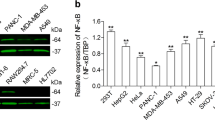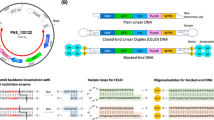Abstract
Tpr-Met, the oncogenic counterpart of the Met receptor, has been detected in gastric cancers, as well as in precursor lesions and in the adjacent normal gastric mucosa. This has prompted the suggestion that Tpr-Met may predispose to the development of gastric tumors. Given the sequence specificity of RNA interference, oncogenes activated by point mutation or rearrangements can be targeted while spearing the product of the wild-type allele. In this work, we report specific suppression of Tpr-Met expression and inhibition of Tpr-Met-mediated transformation and tumorigenesis by means of a short interfering RNA (siRNA) directed toward the Tpr-Met junction (anti-TM2). When delivered by a lentiviral vector, anti-TM2 siRNA was effective also in mouse embryonal fibroblasts or epithelial cells expressing high levels of Tpr-Met. Our results suggest that lentiviral-mediated delivery of anti-TM2 siRNA may be developed into a powerful tool to treat Tpr-Met-positive cancers.
This is a preview of subscription content, access via your institution
Access options
Subscribe to this journal
Receive 12 print issues and online access
$259.00 per year
only $21.58 per issue
Buy this article
- Purchase on Springer Link
- Instant access to full article PDF
Prices may be subject to local taxes which are calculated during checkout





Similar content being viewed by others
References
Fire A, Xu S, Montgomery MK, et al. Potent and specific genetic interference by double-stranded RNA in Caenorhabditis elegans. Nature. 1998;391:806–811.
Kennerdell JR, Carthew RW . Use of dsRNA-mediated genetic interference to demonstrate that frizzled and frizzled 2 act in the wingless pathway. Cell. 1998;905:1017–1026.
Brummelkamp TR, Bernards R, Agami R . A system for stable expression of short interfering RNAs in mammalian cells. Science. 2002;296:550–553.
Lee NS, Dohjima T, Bauer G, et al. Expression of small interfering RNAs targeted against HIV-1 rev transcripts in human cells. Nat Biotechnol. 2002;20:500–505.
Miyagishi M, Taira K . Development and application of siRNA expression vector. Nucleic Acids Res. 2002;2 (Suppl):113–114.
Paddison PJ, Caudy AA, Bernstein E, et al. Short hairpin RNAs (shRNAs) induce sequence-specific silencing in mammalian cells. Genes Dev. 2002;16:948–958.
Kawasaki H, Taira K . Short hairpin type of dsRNAs that are controlled by tRNA(Val) promoter significantly induce RNAi-mediated gene silencing in the cytoplasm of human cells. Nucleic Acids Res. 2003;31:700–707.
Brummelkamp TR, Bernards R, Agami R . Stable suppression of tumorigenicity by virus-mediated RNA interference. Cancer Cell. 2002;2:243–247.
Barton GM, Medzhitov R . Retroviral delivery of small interfering RNA into primary cells. Proc Natl Acad Sci USA. 2002;99:14943–14945.
Qin XF, An DS, Chen IS, et al. Inhibiting HIV-1 infection in human T cells by lentiviral-mediated delivery of small interfering RNA against CCR5. Proc Natl Acad Sci USA. 2003;100:183–188.
Rubinson DA, Dillon CP, Kwiatkowski AV, et al. A lentivirus-based system to functionally silence genes in primary mammalian cells, stem cells and transgenic mice by RNA interference. Nat Genet. 2003;33:401–406.
van de Wetering M, Oving I, Muncan V, et al. Specific inhibition of gene expression using a stably integrated, inducible small-interfering-RNA vector. EMBO Rep. 2003;4:609–615.
Czauderna F, Santel A, Hinz M, et al. Inducible shRNA expression for application in a prostate cancer mouse model. Nucleic Acids Res. 2003;31:e127.
Chen Y, Stamatoyannopoulos G, Song CZ . Down-regulation of CXCR4 by inducible small interfering RNA inhibits breast cancer cell invasion in vitro. Cancer Res. 2003;63:4801–4804.
Birchmeier C, Birchmeier W, Gherardi E, et al. Met, metastasis, motility and more. Nat Rev Mol Cell Biol. 2003;4:915–925.
Tempest PR, Reeves BR, Spurr NK, et al. Activation of the met oncogene in the human MNNG-HOS cell line involves a chromosomal rearrangement. Carcinogenesis. 1986;7:2051–2057.
Rodrigues GA, Park M . Dimerization mediated through a leucine zipper activates the oncogenic potential of the met receptor tyrosine kinase. Mol Cell Biol. 1993;13:6711–6722.
Sharashidze LK, Beniashvili DSh, Sherenesheva NI, et al. Induction of gastric cancer in monkeys by N-methyl-N-nitro-N-nitrosoguanidine (MNNG). Neoplasma. 1989;36:129–133.
Soman NR, Correa P, Ruiz BA, et al. The TPR-MET oncogenic rearrangement is present and expressed in human gastric carcinoma and precursor lesions. Proc Natl Acad Sci USA. 1991;88:4892–4896.
Yu J, Miehlke S, Ebert MP, et al. Frequency of TPR-MET rearrangement in patients with gastric carcinoma and in first-degree relatives. Cancer. 2000;88:1801–1806.
Deng D, Xin H . Formation of N-(nitrosomethyl)urea in stomachs of experimental pigs and human volunteers given fish sauce in vivo. J Agric Food Chem. 2000;48:2495–2498.
Sen NP, Seaman SW, Badoo PA, et al. Formation of N-nitroso-N-methylurea in various samples of smoked/dried fish, fish sauce, seafoods, and ethnic fermented/pickled vegetables following incubation with nitrite under acidic conditions. J Agric Food Chem. 2001;49:2096–2103.
Danilkovitch-Miagkova A, Zbar B . Dysregulation of Met receptor tyrosine kinase activity in invasive tumors. J Clin Invest. 2002;109:863–867.
Lee JH, Han SU, Cho H, et al. A novel germ line juxtamembrane Met mutation in human gastric cancer. Oncogene. 2000;19:4947–4953.
Ma PC, Kijima T, Maulik G . c-MET mutational analysis in small cell lung cancer: novel juxtamembrane domain mutations regulating cytoskeletal functions. Cancer Res. 2003;63:6272–6281.
Shinomiya N, Vande Woude GF . Suppression of met expression: a possible cancer treatment. Clin Cancer Res. 2003;9:5085–5090.
Ma PC, Maulik G, Christensen J, et al. c-Met: structure, functions and potential for therapeutic inhibition. Cancer Metast Rev. 2003;22:309–325.
Morotti A, Mila S, Accornero P, et al. K252a inhibits the oncogenic properties of Met, the HGF receptor. Oncogene. 2002;21:4885–4893.
Sattler M, Pride YB, Ma P, et al. A novel small molecule met inhibitor induces apoptosis in cells transformed by the oncogenic TPR-MET tyrosine kinase. Cancer Res. 2003;63:5462–5469.
Christensen JG, Schreck R, Burrows J, et al. A selective small molecule inhibitor of c-Met kinase inhibits c-Met-dependent phenotypes in vitro and exhibits cytoreductive antitumor activity in vivo. Cancer Res. 2003;63:7345–7355.
Maritano D, Accornero P, Bonifaci N, et al. Two mutations affecting conserved residues in the Met receptor operate via different mechanisms. Oncogene. 2000;19:1354–1361.
Elbashir SM, Harborth J, Lendeckel W, et al. Duplexes of 21-nucleotide RNAs mediate RNA interference in cultured mammalian cells. Nature. 2001;411:494–498.
Follenzi A, Ailles LE, Bakovic S, et al. Gene transfer by lentiviral vectors is limited by nuclear translocation and rescued by HIV-1 pol sequences. Nat Genet. 2000;25:217–222.
Weidner KM, Arakaki N, Hartmann G, et al. Evidence for the identity of human scatter factor and human hepatocyte growth factor. Proc Natl Acad Sci USA. 1991;88:7001–7005.
Goldman JM, Melo JV . Chronic myeloid leukemia — advances in biology and new approaches to treatment. N Engl J Med. 2003;349:1451–1464.
Croom KF, Perry CM . Imatinib mesylate: in the treatment of gastrointestinal stromal tumours. Drugs. 2003;63:513–522.
Bose S, Deininger M, Gora-Tybor J, et al. The presence of typical and atypical BCR-ABL fusion genes in leukocytes of normal individuals: biologic significance and implications for the assessment of minimal residual disease. Blood. 1998;92:3362–3367.
Yang G, Thompson JA, Fang B, et al. Silencing of H-ras gene expression by retrovirus-mediated siRNA decreases transformation efficiency and tumor growth in a model of human ovarian cancer. Oncogene. 2003;22:5694–5701.
Scherr M, Battmer K, Winkler T, et al. Specific inhibition of bcr-abl gene expression by small interfering RNA. Blood. 2003;101:1566–1569.
Hingorani SR, Jacobetz MA, Robertson GP, et al. Suppression of BRAF(V599E) in human melanoma abrogates transformation. Cancer Res. 2003;63:5198–5202.
Li K, Lin SY, Brunicardi FC, Seu P . Use of RNA interference to target cyclin E-overexpressing hepatocellular carcinoma. Cancer Res. 2003;63:3593–3597.
Filleur S, Courtin A, Ait-Si-Ali S, et al. SiRNA-mediated inhibition of vascular endothelial growth factor severely limits tumor resistance to antiangiogenic thrombospondin-1 and slows tumor vascularization and growth. Cancer Res. 2003;63:2319–2322.
Weinstein IB . Cancer, addiction to oncogenes — the Achilles heal of cancer. Science. 2002;297:63–64.
Acknowledgements
We are grateful to Roberto Piva, Andrea Manazza and Chiara Ambrogio for technical help. This work was supported by funds from the Italian Association for Cancer Research (AIRC, CP), the Oncology Project Compagnia di San Paolo/FIRMS (CeRMS) and PRIN 2003 (CP, LN). Paolo Accornero is a FIRC fellow. The continuing support of the Compagnia di San Paolo and Fondazione CRT to C Ponzetto's laboratory is gratefully acknowledged.
Author information
Authors and Affiliations
Corresponding author
Rights and permissions
About this article
Cite this article
Taulli, R., Accornero, P., Follenzi, A. et al. RNAi technology and lentiviral delivery as a powerful tool to suppress Tpr-Met-mediated tumorigenesis. Cancer Gene Ther 12, 456–463 (2005). https://doi.org/10.1038/sj.cgt.7700815
Received:
Published:
Issue Date:
DOI: https://doi.org/10.1038/sj.cgt.7700815
Keywords
This article is cited by
-
Lack of Diaph3 relaxes the spindle checkpoint causing the loss of neural progenitors
Nature Communications (2016)
-
DNA triplex-mediated inhibition of MET leads to cell death and tumor regression in hepatoma
Cancer Gene Therapy (2011)
-
Silencing the MET oncogene leads to regression of experimental tumors and metastases
Oncogene (2008)
-
The study of RNAi-mediated by conditionally replicating adenovirus silencing on Survivin gene in colon cancer cell lastingly
The Chinese-German Journal of Clinical Oncology (2008)
-
Use of herpes simplex virus type 1-based amplicon vector for delivery of small interfering RNA
Gene Therapy (2007)



